| Day 389 |
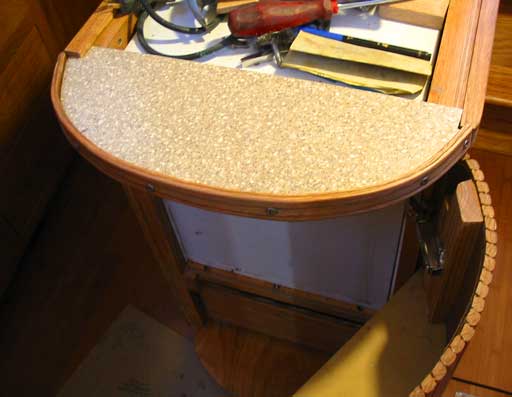 |
Shelf on island & Fw. Bilge pump |
| Bending a 3/8" strip of 1 1/2" oak isn't easy! It fights with every inch of it's being, tries to splinter, and seems unyielding even after staining all of the walls in the kitchen, running up the power bill via boiling a huge pot for hours, and burning my hand twice. Ply is easy, 1/8" oak is easy, this was not. Perhaps it was from a particularly tough tree, maybe it had a rough life or was partially petrified? Whatever the reason, I'll never try this again, not with oak. | ||
After all of the wood torturing, it
doesn't look too bad. The screws will be inset ( one at a time ya
hear??!) and filled over. A hinged breadboard will cover the edge of the
countertop material.
Notice the door is on? I love it! No hinges showing, no seam either. Just a smooth transition just the way I imagined it. Beautiful! The long skinny photo to the right is of the end section and cap. The lighter color of the closer tambour results from being one stain coat behind the rest. The top rail is 2 or 3 behind. |
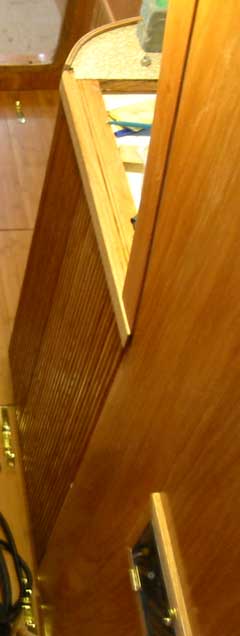 |
|
| Below is looking down on the
latch attempt I made. It works well now, but only time, wear and tear,
quality of the antenna whip material ( which I don't believe is actual
stainless due to it's coppery looking appearance when scraped with
pliers! ) and ease of use will tell. Gena liked it, and it's a neat
solution to an annoying problem; how to keep the door closed. I'll probably do a better remake with "real" stainless rod and a proper rod bender that is mounted on the counter at the shop. It was given to me by a customer who was impressed with my bending work on the hull fixtures. It has little pins in a jig that can be moved around to allow different bends to be made, and little slots for tight bends. Great for making fish hooks etc. I was thinking on keeping it, attaching it under a floor hatch that could be flipped up when/if needed. Problem is, all the little pins would fall out. Duh! I'm keeping it anyway. |
||
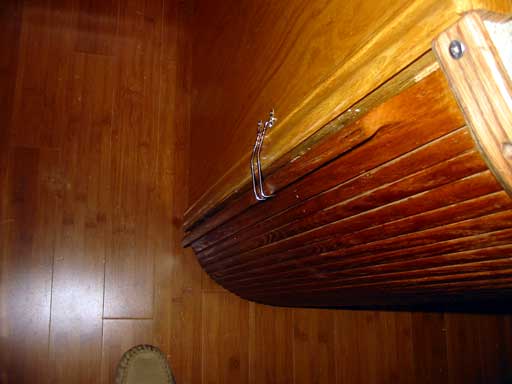
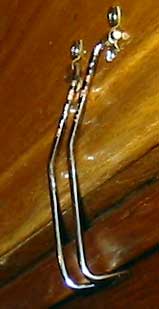 |
||
| The only thing left to do here is put on the shelf faces to hold the "stuff" in place. I somehow forgot all about that part. Oh well, there's always another day. | ||
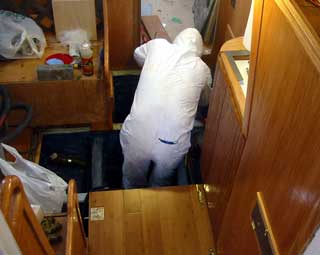 |
Once again Gena has donned the "Andromeda
Strain" suit to apply more Blue Stuff, this time a second coat down the
forward web of the bilge and around the forward most trim ballast hatch.
She has really been using the "stuff" lately! And I laughed when she
bought three more cans of it.... Joke's on me. We would have run out
about 3 months ago. . |
||
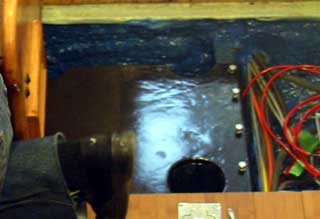 |
The mast plate has been sitting/moved
around all over the boat for months now and seemed happy to be put into
it's proper place at last. We'll miss using it for a weight and a
hammering surface etc. but all things must come to an end, and it's in a
better place now :) If you remember back when Gena cut it ( and ruined my plasma cutter gun ) the holes are meant to access the trim ballast hatch lid. This is so we can put in more lead without taking down the mast off. It wouldn't be very good for taking the lead back out though lol! |
||
 |
|
||
|
An important piece of info about installing
a bilge pump: It should definitely have it's own breaker. We think it
should be the auto resetable type in case a surge trips it without
anyoneever knowing. Usually when a boat gets swamped for whatever
reason, we have noticed that the electrical takes the first hit. It's
almost unavoidable. If the battery mains throw due to other circuits
shorting, the bilge on those mains won't work either. Time for
some arm exercise! The manual side of the switch (purchased from digikey) is spring action. Not ideal for pumping out, but the switch shouldn't fail. Chances are the motor would fail first. I think it is mostly just to get the remainder of water out once the switch can't float anymore. Gena mounted the thing on a flat slice of lead and coated it. That should hold it down! |
|||

Day 389 :
7 hours - Forward bilge pump installed